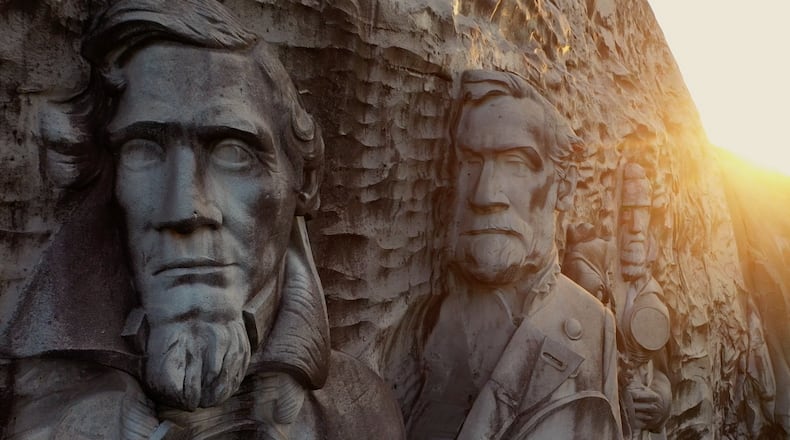Across the 32 minutes of the Atlanta History Center’s first-ever original documentary, titled “Monument: The Untold Story of Stone Mountain,” the film candidly tackles the carving on the mountain’s northern face and its often glossed-over history.
It’s an ugly, racist past with ties to the whitewashing of the Civil War and the antebellum South; the Ku Klux Klan; and resistance to desegregation. The massive likenesses of Jefferson Davis, Stonewall Jackson and Robert E. Lee were completed just 50 years ago, within the lifetimes of most Georgians, their parents or grandparents.
Laying out those unvarnished truths — and laying the foundation for a more informed conversation — is the core mission of the documentary, which premiered at a Wednesday night event before its public release Thursday.
But the film is also not shy about highlighting again and again, the role that state leaders old and new have played in creating and otherwise sanctioning the world’s largest Confederate monument. It closes with a post-credits scene of history center president Sheffield Hale characterizing the 2001 law protecting the carving as the clearest example of Lost Cause ideology “anywhere.”
“I think right now the role we can play is to get more of the history out, so they can have a more robust conversation about it,” Hale told the AJC. “That’s for the citizens of Georgia everywhere. But also the legislators.”
The documentary marks the first entry in a new direction for the history center, a decades-old institution that’s looking to expand its reach through more digital projects.
Offering interviews with historians and activists and the daughter of the man who physically created the carving, “Monument” is a product two years in the making.
“We see this as part of our future as a history center, to reach beyond the wall,” director Kristian Weatherspoon, the center’s vice president of digital storytelling, said.
It’s a big leap.
It’s also timely.
The history center produced a white paper offering a “condensed history of the Stone Mountain carving” in 2017, in the wake of the Charleston church massacre and the renewed national discussion over Confederate symbols. Things have only ratcheted up since.
Amid 2020′s protests over police killings and racial justice, local NAACP branches and the newly formed Stone Mountain Action Coalition launched fresh campaigns pressuring the state authority that controls Stone Mountain Park to address its bounty of Lost Cause tributes.
It’s been a bit of a winding road since then, and activists are far from satisfied: they just recently started a new petition demanding that all Confederate symbols, including the names of roads and other park features, be addressed.
But the movement has led to at least the promise of other modest changes.
Stone Mountain Memorial Associations leaders vowed nearly two years ago to relocate the Confederate flags that have long flown at the base of the mountain’s popular walk-up trail. CEO Bill Stephens said last week that it’s still the plan, but he didn’t “have a timeline to disclose.”
The memorial association did recently select a firm to design and build a new on-site museum exhibit that will aim to “tell the truth” about the mountain and the carving. The initial proposal from Warner Museums seemingly shows a willingness to dive into much of the same history explored in the Atlanta History Center’s new documentary.
The carving was originally conceived in the 1910s, as “Birth of a Nation,” the film glorifying the Ku Klux Klan’s reign of terror during Reconstruction, swept the nation — and inspired the rebirth of the Klan on Stone Mountain itself.
Wars, infighting and financial issues ultimately doomed the original attempt. Decades later, and just weeks after the Supreme Court handed down its watershed ruling in Brown v. Board of Education, soon-to-be Georgia Gov. Marvin Griffin vowed that the state would purchase the mountain and complete the carving.
It was finished in 1972, more than a century after the end of the Civil War.
The park, Emory University historian Joseph Crespino says in the film, is “a place that memorializes people who fought for a version of the country that we reject today.”
“A lot of people just don’t even know,” Cynthia Spence, co-chair of anthropology and sociology at Spelman College, says. “They’d don’t understand that Stone Mountain, as well as many Confederate monuments all over this country, were very intentionally placed to keep Black people in their places.”
“Monument: The Untold Story of Stone Mountain” will be available for public consumption at atlantahistory.com/monument.
Georgia Code 50-3-1c
“Any other provision of law notwithstanding, the memorial to the heroes of the Confederate States of America graven upon the face of Stone Mountain shall never be altered, removed, concealed, or obscured in any fashion and shall be preserved and protected for all time as a tribute to the bravery and heroism of the citizens of this state who suffered and died in their cause.”
About the Author
The Latest
Featured


